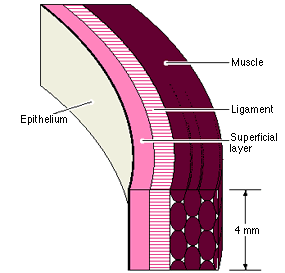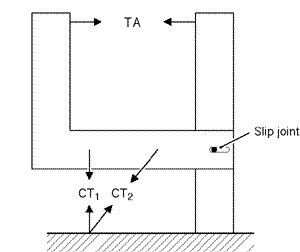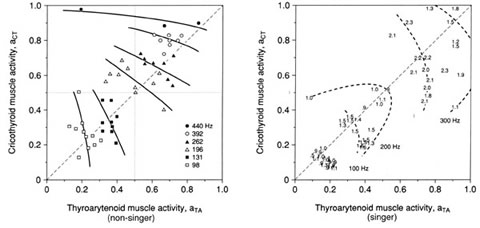How humans control pitch
What's the difference between fundamental frequency and pitch? These
terms are
often used interchangeably, although there is a subtle difference. Pitch is
a perceptual measure; in other words, pitch must be heard and measured by ears
connected to a brain. Fundamental frequency, by
definition, does not have to be sensorially perceived. Rather it is a measurement
of sound wave's base frequency that can be quantified by an instrument such as
a spectrograph. Thus, fundamental frequency - or Fo - is the more accurate scientific
term and will
be used throughout this section.
Simply stated, Fo is controlled by:
- a change in length of the vocal folds;
- a change in the stress of the tissues of the vocal folds.
Tissue Composition & Characteristics
To fully understand the mechanisms of pitch control, it is helpful to first review
the tissue composition of the vocal folds and to recall that different tissues
types have unique biomechanical properties. The epithelium, the thin skin that
covers the vocal fold, is a loose material that can't hold much tension. However,
deeper vocal fold tissues - collagen, elastin and muscle - exhibit some resistance
to stretching,
but can become quite stiff.

During soft talking or falsetto singing, only the highly
pliable cover of the vocal fold - the epithelium and underlying fatty tissue
- is vibrating. Because only the properties of this superficial layer must
be considered, scientists can describe Fo control with a relatively simple
model: the Cover Model of Fo Control. However, during speech at a
normal loudness or chest and head singing, deeper layers of the vocal folds
are set into vibration. Because of the involvement of multiple layers, a
more complicated model of the vocal folds must be used: the Body-Cover
Model of Fo Control.
Roles of the TA and CT Muscles
The tension of the vocal fold is the primary determinant of Fo control. Just
as a guitar string or a rubber band can be stretched to produce a higher
pitch when plucked, increased stress on vocal fold fibers produces an increase
in Fo. Recall from your background in vocal anatomy that the actions of
the cricothyroid (CT) and thyroarytenoid (TA) muscles shorten or lengthen
the vocal folds. It may be helpful to remember:
- The TA muscles shorten the vocal folds;
- The CT muscles lengthen the vocal folds by pulling the
thyroid cartilage forward.
It is also important to understand that these muscles can work independently
of one another in regulating Fo. A number of muscle activation studies conclude
that speakers and singers - particularly trained vocalists - tend to balance
CT and TA muscle activity, utilizing neither to its maximum potential. Researchers
theorize that humans naturally are inclined to use all or
none of a particular muscle. Training can help vocalists use just
part of a particular
laryngeal muscle's capability.
Also, researchers have found that a rise in Fo is generally
obtained by an increase in TA activity so long as CT activity is not near
its maximum. The following animation demonstrates how the CT and TA muscles
move in an excised human larynx.

The relationship between vocal fold length and Fo is non-linear.
In other words, incremental increases in vocal fold length do not produce
similar step-wise increases in Fo. You can test this phonemenon yourself.
Stretch a small rubber band between your thumb and forefinger. The elasticity
of a rubber band is similar to that of vocal fold tissue. Pluck it while
holding it loosely (little tension in the rubber). Now, stretch the rubber
band a little more; do you hear a discernable rise in pitch? Probably not.
Next, elongate the rubber band to near its limit. You should hear a significant
rise in pitch. Scientists can quantitatively predict the upward shift in
Fo, using this relationship: Fo will rise only if the square root of stress
increases with length more than the length itself increases. Equation
8.7 expresses this relationship quantitatively.
Cover Model of Fo control
The key concept of the cover model is this: in falsetto or soft phonation when
vibrational amplitudes are small, oscillation is primarily taking place
in the cover. The tension of the vocal folds is determined by length only.
Scientists continue to study how much control singers and speakers have
in regulating the depth of vibration of the cover. They hypothesize that
the vocal ligament (the area between the epithelium and the TA muscle)
may play a major role in absorbing stress, leaving the superficial layers
loose for vibration at high fundamental frequencies.
A quantitative analysis of the cover model reveals that a
positive change in TA muscle activity always causes a decrease in Fo. Conversely,
increasing CT activity increases Fo. The differential action between the
TA and CT muscles is also apparent in the vocal
strain equation (8.6). In essence, the TA and CT have opposing effects
on the change of length.

Body-Cover Model
of Fo control
The body-cover model involves more means of Fo control than does the cover
model (where CT does everything). These means or variables of control are 1)
the depth or amount of tissue vibrating (into the vocal fold or away from the
surface), and 2) the activation of the TA muscle. As the depth of vibration
increases, TA activation has a greater positive correlation with Fo, and of
course, if the TA isn't activated, the body-cover model is no different than
the cover model. These means of controlling Fo are all found in Equation 8.8.

It is probably beyond the scope of most vocologists to memorize
the complexities of different, but adjacent, tissues vibrating according
to their biomechanical characteristics. However, the ability to quantify
the relationship between amount of muscle in vibration with stress and vocal
fold length to predict Fo is essential to scientists modeling various types
of phonation.
Effect of Lung Pressure on Fo
As more air is pushed from the lungs past the vocal folds, Fo usually rises.
This can easily be demonstrated. Make an 'ah' sound at a low comfortable
pitch, then press with your fingertips inwardly just below the sternum.
Do you hear the sharp rise in pitch? This phenomenon is more noticeable
at lower frequencies (when the vocal fold lengths are shorter) than at
higher pitches.
Thus, humans have a number of strategies for controlling
Fo:
- changes in activity of the TA muscle
- changes in activity of the CT muscle
- increasing or decreasing amounts of air from the lungs
Not surprisingly, speakers and singers are interested in
optimal combinations of these strategies for Fo control. Let's compare muscle
activation plots (of the thyroarytenoid muscle and cricothyroid muscle) from
a non-singer and a trained singer:

Interestingly, the graphs are quite similar. Both the trained
and the untrained vocalist tended to use the TA and CT muscles equally, as
seen by the dashed diagonal lines running at 45-degree angles through the
graphs.
Finally, there are also some physical limitations of the
system, for example, the size of an individual's cricothyroid space. How
does yours measure up? Keep your chin level and relax your neck muscles.
Locate your larynx with your fingertips. It should be fairly easy to palplate
the thyroid notch at the top of the larynx (the upper edge of the Adam's
apple) at the top of larynx to locate the length of the thyroid cartilage.
Move your fingertip downward. Is the crycoid cartilage close in proximity
to the bottom of the thryoid cartilage? If so, there may be limited room
to rotate the cricoid cartilage toward the thyroid cartilage. Clearly, this
is a relative measurement, so it might be an interesting experiment to feel
not only your own, but the cricothyroid space among your VERY CLOSE friends.
Tutorials Homepage

|



